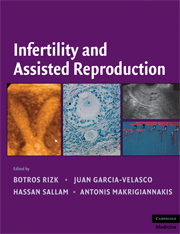Book contents
- Frontmatter
- Contents
- Contributors
- Foreword
- Preface
- Introduction
- PART I PHYSIOLOGY OF REPRODUCTION
- 1 Folliculogenesis: From Preantral Follicles to Corpus Luteum Regression
- 2 Mechanisms of Follicular Development: The Role of Gonadotrophins
- 3 Human Follicle Culture In Vitro
- 4 Endometrial Receptivity
- 5 Molecular Mechanisms of Implantation
- PART II INFERTILITY EVALUATION AND TREATMENT
- PART III ASSISTED REPRODUCTION
- PART IV ETHICAL DILEMMAS IN FERTILITY AND ASSISTED REPRODUCTION
- Index
- Plate section
- References
3 - Human Follicle Culture In Vitro
from PART I - PHYSIOLOGY OF REPRODUCTION
Published online by Cambridge University Press: 04 August 2010
- Frontmatter
- Contents
- Contributors
- Foreword
- Preface
- Introduction
- PART I PHYSIOLOGY OF REPRODUCTION
- 1 Folliculogenesis: From Preantral Follicles to Corpus Luteum Regression
- 2 Mechanisms of Follicular Development: The Role of Gonadotrophins
- 3 Human Follicle Culture In Vitro
- 4 Endometrial Receptivity
- 5 Molecular Mechanisms of Implantation
- PART II INFERTILITY EVALUATION AND TREATMENT
- PART III ASSISTED REPRODUCTION
- PART IV ETHICAL DILEMMAS IN FERTILITY AND ASSISTED REPRODUCTION
- Index
- Plate section
- References
Summary
INTRODUCTION
The functions of the female gonad are to produce mature oocytes for fertilization and to provide a proper environment for supporting embryo development and pregnancy. Primordial follicles represent the earliest stage of follicular development in the mammalian ovary, and the size of the primordial follicle pool is the major determinant in female fertility potential. Ovarian folliculogenesis starts with the activation of resting primordial follicles. These follicles subsequently develop through primary, secondary, and antral stage to finally reach the preovulatory stage. In response to luteinizing hormone (LH) surge, the preovulatory follicles ovulate to release the mature oocytes, while the remaining theca and granulosa cells differentiate to form the corpus luteum. Ovarian folliculogenesis is regulated by various endocrine, paracrine, and autocrine factors as well as intraovarian cell-cell and cell-matrix interaction (1). It is established that the coordination between the oocyte and the surrounding granulosa, and theca cells is critical for the appropriate development of the follicles (2). However, extensive knowledge is still required to completely understand the earliest stages of folliculogenesis. In vivo studies of naturally occurring gene mutations (3–5) and creation of gene knockout animal models (6) have been used to attempt at identifying candidate growth factors involved in the regulation of follicular development. The lack of full knowledge of the physiological regulators of the earliest follicular stages, the length of the earliest stages of folliculogenesis in larger mammals, and the limited amount of available human samples of comparable quality for research have hampered the development of follicle culture systems for both humans and larger animals.
Keywords
- Type
- Chapter
- Information
- Infertility and Assisted Reproduction , pp. 25 - 37Publisher: Cambridge University PressPrint publication year: 2008
References
- 2
- Cited by



